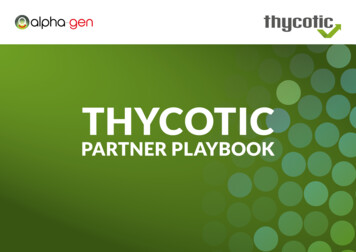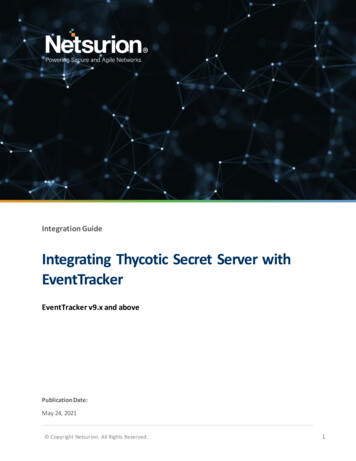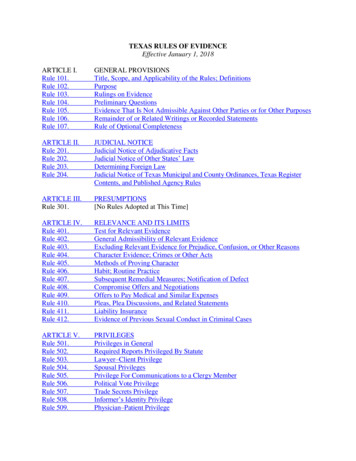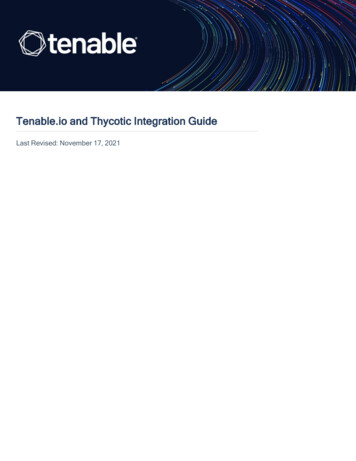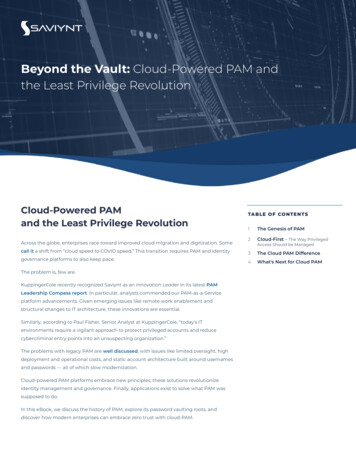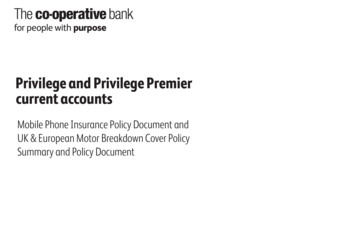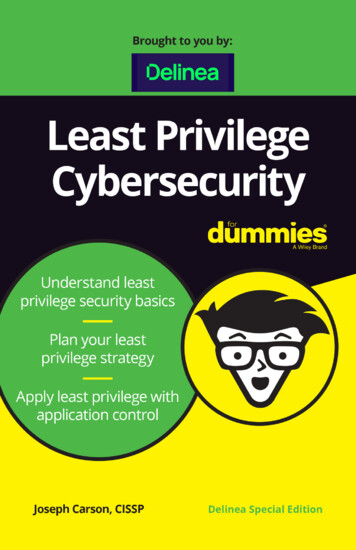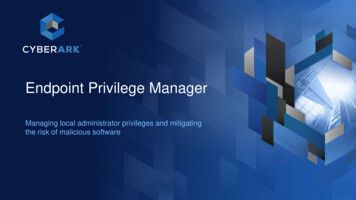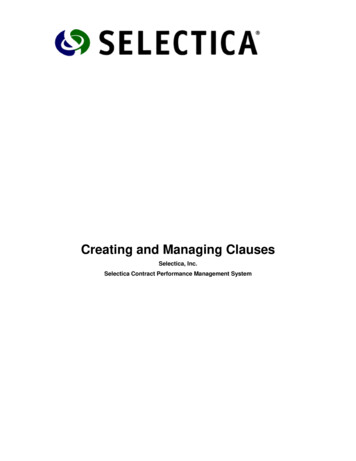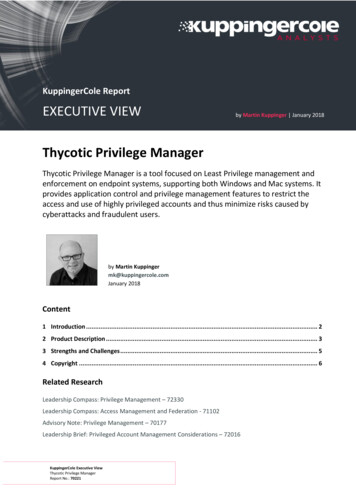
Transcription
KuppingerCole ReportEXECUTIVE VIEWby Martin Kuppinger January 2018Thycotic Privilege ManagerThycotic Privilege Manager is a tool focused on Least Privilege management andenforcement on endpoint systems, supporting both Windows and Mac systems. Itprovides application control and privilege management features to restrict theaccess and use of highly privileged accounts and thus minimize risks caused bycyberattacks and fraudulent users.by Martin Kuppingermk@kuppingercole.comJanuary 2018Content1 Introduction . 22 Product Description . 33 Strengths and Challenges . 54 Copyright . 6Related ResearchLeadership Compass: Privilege Management – 72330Leadership Compass: Access Management and Federation - 71102Advisory Note: Privilege Management – 70177Leadership Brief: Privileged Account Management Considerations – 72016KuppingerCole Executive ViewThycotic Privilege ManagerReport No.: 70221
1 IntroductionPrivilege Management is an IT Security discipline with many facets. It can be considered as being part ofboth Cybersecurity and IAM (Identity & Access Management). On the one hand, it is an essentialelement in protecting organizations against cyberattacks, by limiting the damage attackers can cause.Targeted attacks are always after accounts with highly elevated privileges on sensitive and criticalsystems: privileged accounts. Getting access to these allows attackers to access organization’s criticalinformation. On the other hand, Privilege Management is also part of IAM through helping organizationsbetter managing entitlements, not only of individual user accounts but also shared accounts such asadministrative accounts and system accounts.Modern tools for Privilege Management must support a variety of requirements, from protecting thepasswords of shared accounts, rotating the passwords of service and system accounts, to sessionmonitoring and behavioral analytics.Mature Privilege Management solutions go much further than simple password generation and accesscontrol to individual systems, but also provide a unified, robust, and – importantly - transparentPrivilege Management platform which is integrated into an organization’s overall Identity and AccessManagement (IAM) strategy. While “password vaults” had been at the center of attention in earlieryears, capabilities such as privilege elevation management and enforcement of the “least privilege”principle, advanced analytics of privileged user behavior, and advanced capabilities in sessionmonitoring and analysis are becoming the new normal, increasingly integrated into comprehensivesuites.Among security risks associated with privileged users are: Leakage of credentials for shared accounts; Abuse of elevated privileges by fraudulent users; Hijacking of privileged accounts by cyber-criminals; Risks through abuse of elevated privileges on client systems; Risks through mistakes in using elevated privileges by users.Furthermore, there are several areas of security, but also user convenience, with requirements whichare associated with privileged accounts: Managing the ownership and knowing all privileged accounts, both individual and shared accounts; Single Sign-On to shared accounts for administrators and operators; Reducing elevated privileges of administrators, and in particular operators, but also shared accountssuch as system accounts, to mitigate associated risks; Controls for managing, restricting, and monitoring access of MSPs when accessing internal systems; Controls for managing, restricting, and monitoring access of internal users to cloud services.KuppingerCole Executive ViewThycotic Privilege ManagerReport No.: 70221Page 2 of 7
Consequently, multiple technologies and solutions have been developed to address these risks as well asprovide better activity monitoring and threat detection. Among these solutions, technologies forApplication Control and Least Privilege Management play an important role. Such tools allow, as listedabove, minimizing elevated privileges for various types of accounts and thus mitigating the associatedrisks.Such tools are, of course, relevant on servers, to reduce privilege elevation of administrators. However,the common entry point of attackers and even of malicious users is not the server, but the endpoint.This is where targeted attacks relying on privilege elevation commonly start. Thus, getting a grip on theapplications and their entitlements as well as the built-in accounts such as service accounts, useraccounts, and local administrator accounts is an essential piece in protecting the information assets ofany organization. Such tools, which are commonly referred to as Endpoint Privilege Management, mustsupport the common endpoint platforms, i.e. Windows and Mac.For a detailed overview of the leading PxM vendors, please refer to the KuppingerCole LeadershipCompass on Privilege Management1.2 Product DescriptionThycotic is a U.S. based vendor of Privilege Management solutions. Their flagship product Secret Servercovers a variety of capabilities of Privilege Management, including Shared Account PasswordManagement, Session Management, and Privileged User Behavior Analytics. With the acquisition ofArellia in 2016, the company strengthened their portfolio in Endpoint Privilege Management andApplication Control The offering now is marketed as Thycotic Privilege Manager.The tool supports both Windows and Mac clients and thus the vast majority of the endpoints inorganizations, aside from smartphones. It focuses on restricting local admin access on these systems.Analyzing the Microsoft Security Bulletins for recent years, it becomes apparent that virtually all criticalvulnerabilities require access to highly privileged accounts on endpoints to become effective. Controllingthese accounts and their capabilities is thus a highly effective and, in consequence, mandatory action aspart of a cybersecurity program.Thycotic Privilege Manager does so through a combination of application control and the managementof privileges. Application control manages which applications are allowed to run and which are blocked,but also provides an interface for users to request access to certain applications. Furthermore, unknownapplications can be isolated in a sandbox, quarantined, or sent through an approval workflow.With the Privilege Management capabilities, standard users can get defined access without requiring theuse of the UAC (User Access Control) features of Windows that require administrator actions whenperforming administrative activities.Thus, standard activities such as installing printers can be simplified while critical access is restricted. Italso manages scripts and the capabilities of 3rd party applications.1Leadership Compass: Privilege Management (#72330)KuppingerCole Executive ViewThycotic Privilege ManagerReport No.: 70221Page 3 of 7
Thycotic Privilege Manager works with a five-step process, based on an inventory of users and systemsand their access: The first step is building an inventory of local users and groups and identifying the users and accountswith privileged access. Following this, events are discovered, particularly focused on the user accounts that are used and theprocesses and executables running on the systems. Based on that information, privileged accounts can be centrally managed and privileged groupmembership can be restricted. Policies are used to manage that access. At runtime, the locally installed agent listens for all executables and processes running and appliespolicies, which then might grant or restrict access. Applying the defined action such as allowing an application to run, elevating the entitlements of asingle application, denying an application, or requesting approval for access is the final step.This process is based on a set of features, starting with discovery capabilities. Thycotic has implementeddiscovery capabilities for years for their other Privilege Management and System Administrationsolutions. Based on these, both accounts and applications can be identified.Local accounts then can be managed centrally, including removing local admin rights by settingendpoints into what Thycotic calls as “clean-state”, and provisioning accounts to the local systems.Passwords for accounts that don’t require interactive logins can be randomized. This is one of the areaswhere Thycotic Privilege Manager integrates with Thycotic Secret Server. Although password storageand rotation does not require Secret Server, customers of both will be able to utilize the enterprise levelfeatures of Secret Server beyond vaulting and rotation. Additionally, having an agent on the machineallows local accounts to be changed on endpoints where Microsoft has prevented remote managementand also ensures that there are no firewall or port security issues.Based on policies, applications can be controlled. The tool supports whitelisting, blacklisting (which canbe integrated with threat intelligence databases for automation), and greylisting. The latter defineswhich applications shall be isolated and run in restricted mode. This is one of the areas wheresandboxing comes into play, quarantining applications and limiting their entitlements.Other major features include: contextual control to manage who can run processes on different endpoints, in different regions,during certain times, etc.; limitations for child processes, such as executing processes from a PDF file; application-based policies that control access per application, centrally, for all users; and auditing and reporting capabilities.Importantly, Thycotic Privilege Manager is independent of Active Directory domains. It can utilize thesefor simplified management but does not depend on domains being in place and endpoints beingmember of domains.KuppingerCole Executive ViewThycotic Privilege ManagerReport No.: 70221Page 4 of 7
Aside from the integration to Thycotic Secret Server, the tool also comes with out-of-the-boxintegrations to work with other tools such as ServiceNow for inventory and for helpdesk workflows.Other useful integrations that ensure Privilege Manager fits into existing layers of security includeMicrosoft SCCM, Microsoft WSUS, Symantec, and SIEM providers.Thycotic has modernized the user interface (UI) in the current version, significantly simplifyingadministration. Aside from the standard administrative UI, there is also a mobile app available whichallows IT or helpdesk to manage systems from their mobile devices.A major roadmap item is a cloud version of the product that will allow managing endpoint privilegesfrom the cloud, without any local install. With the ongoing convergence of IT infrastructures to thecloud, this becomes an essential requirement for organizations.3 Strengths and ChallengesThycotic Privilege Manager is a mature and well-thought-out solution, which allows restricting privilegeelevation for applications and the underlying processes. It supports machines that are part of Windowsdomains as well as those that aren’t, which becomes increasingly important for organizations that, e.g.,only use Azure Active Directory, but no Active Directory on premises. For these, the upcoming cloudversion of Thycotic Privilege Manager will be another important step forward. The UI makes themanagement simple and straightforward and is adequate for the targeted groups of users.Given that Windows and the related tools such as Active Directory Group Policies or App Locker don’tprovide the full breadth of capabilities required to lock down Windows clients and that these also don’tsupport Mac systems, additional solutions such as Thycotic Privilege Manager are essential.Thycotic’s solution is a strong offering in that market segment and should be part of product selectionprocesses. It also is a mandatory addition to the traditional Privilege Management solutions, which lackthe support for the specific requirements of Endpoint Privilege Management.StrengthsChallenges Efficient, policy-based management of Growing, but still relatively small partner application entitlements and local privilegedaccess on endpointsSupports a variety of capabilities forcontrolling and restricting accessModernized UI and mobile app formanagement availableIntegration out-of-the-box and via APIs intoThycotic Secret Server, ServiceNow, and othertoolsAllows users to request additional accesswhenever requiredKuppingerCole Executive ViewThycotic Privilege ManagerReport No.: 70221ecosystem on global scale Cloud-based solution not available yet, butroadmap item for mid-2018Page 5 of 7
4 Copyright 2018 Kuppinger Cole Ltd. All rights reserved. Reproduction and distribution of this publication in any form is forbidden unlessprior written permission. All conclusions, recommendations and predictions in this document represent KuppingerCole’s initialview. Through gathering more information and performing deep analysis, positions presented in this document will be subject torefinements or even major changes. KuppingerCole disclaim all warranties as to the completeness, accuracy and/or adequacy ofthis information. Even if KuppingerCole research documents may discuss legal issues related to information security andtechnology, KuppingerCole do not provide any legal services or advice and its publications shall not be used as such.KuppingerCole shall have no liability for errors or inadequacies in the information contained in this document. Any opinionexpressed may be subject to change without notice. All product and company names are trademarks or registered trademarksof their respective holders. Use of them does not imply any affiliation with or endorsement by them.KuppingerCole Executive ViewThycotic Privilege ManagerReport No.: 70221Page 6 of 7
The Future of Information Security – TodayKuppingerCole supports IT professionals with outstanding expertise in defining IT strategies and inrelevant decision-making processes. As a leading analyst company, KuppingerCole provides first-handvendor-neutral information. Our services allow you to feel comfortable and secure in taking decisionsessential to your business.KuppingerCole, founded in 2004, is a global Analyst Company headquartered in Europe focusing onInformation Security and Identity and Access Management (IAM). KuppingerCole stands for expertise,thought leadership, outstanding practical relevance, and a vendor-neutral view on the informationsecurity market segments, covering all relevant aspects like: Identity and Access Management (IAM),Governance & Auditing Tools, Cloud and Virtualization Security, Information Protection, Mobile as wellas Software Security, System and Network Security, Security Monitoring, Analytics & Reporting,Governance, and Organization & Policies.For further information, please contact clients@kuppingercole.comKuppinger Cole Ltd.Sonnenberger Straße 1665193 Wiesbaden GermanyPhone 49 (211) 23 70 77 – 0Fax 49 (211) 23 70 77 – 11www.kuppingercole.com
Thycotic Privilege Manager Report No.: 70221 Page 2 of 7 1 Introduction Privilege Management is an IT Security discipline with many facets. It can be considered as being part of . Mature Privilege Management solutions go much further than simple password generation and access control to individual systems, but also provide a unified, robust .
